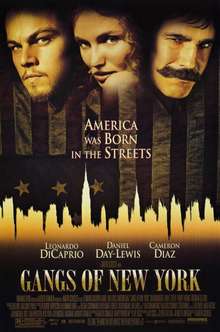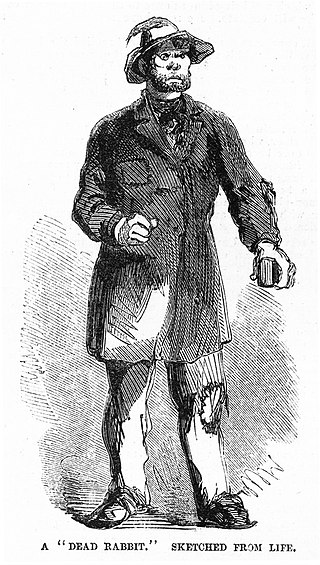A drive-by shooting is a type of assault that usually involves the perpetrator(s) firing a weapon from within a motor vehicle and then fleeing. Drive-by shootings allow the perpetrators to quickly strike their targets and flee the scene before law enforcement is able to respond. A drive-by shooting's prerequisites include access to a vehicle and a gun. The protection, anonymity, sense of power, and ease of escape provided by the get away vehicle lead some motorists to feel safe expressing their hostility toward others.
A gang is a group or society of associates, friends or members of a family with a defined leadership and internal organization that identifies with or claims control over territory in a community and engages, either individually or collectively, in illegal, and possibly violent, behavior.

Gangs of New York is a 2002 American epic historical drama film directed by Martin Scorsese and written by Jay Cocks, Steven Zaillian and Kenneth Lonergan, based on Herbert Asbury's 1927 book The Gangs of New York. The film stars Leonardo DiCaprio, Daniel Day-Lewis and Cameron Diaz, with Jim Broadbent, John C. Reilly, Henry Thomas, Stephen Graham, Eddie Marsan and Brendan Gleeson in supporting roles.

A shirt is a cloth garment for the upper body.

White tie, also called full evening dress or a dress suit, is the most formal in traditional evening western dress codes. For men, it consists of a black tail coat worn over a white dress shirt with a starched or pique bib, white piqué waistcoat and the eponymous white bow tie worn around a standing wing collar. Mid or high-waisted black trousers with galon, a braid of trim consisting of two silk stripes to conceal the outer seams of the trousers, along with court shoes complete the outfit. Orders, decorations and medals may be worn. Acceptable accessories include a black top hat, white gloves, a white scarf, a pocket watch, a white pocket square, and a boutonnière. Women wear full-length ball or evening gowns with evening gloves and, optionally, tiaras, jewellery, and a small handbag.

The Dead Rabbits was the name of an Irish American criminal street gang active in Lower Manhattan in the 1830s to 1850s. The Dead Rabbits were so named after a dead rabbit was thrown into the center of the room during a gang meeting, prompting some members to treat this as an omen, withdraw, and form an independent gang. Their battle symbol was a dead rabbit on a pike. They often clashed with Nativist political groups who viewed Irish Catholics as a threatening and criminal subculture. The Dead Rabbits were given the nicknames of "Mulberry Boys" and the "Mulberry Street Boys" by the New York City Police Department because they were known to have operated along Mulberry Street in the Five Points.
A tailcoat is a knee-length coat characterised by a rear section of the skirt, known as the tails, with the front of the skirt cut away.

The Chichesters also known as the Chichester Gang, along with the Forty Thieves, Shirt Tails, and Kerryonians, were one of the oldest early 19th century Irish Five Points street gangs during the mid 19th century in New York City. The Chichester Gang was organized by its founder John Chichester. The gang got their start by stealing from stores and warehouses and selling the stolen goods to local fences in the 1820s and later became involved in illegal gambling and robbery. An ally of the Dead Rabbits against the Bowery Boys, the Chichesters maintained between 50-100 members lasting for more than 50 years before being absorbed by the Whyos, much like many of the early gangs, following the American Civil War in 1865.
The Mississippi Plan of 1875 was developed by white Southern Democrats as part of the white insurgency during the Reconstruction Era in the Southern United States. It was devised by the Democratic Party in that state to overthrow the Republican Party in Mississippi by means of organized threats of violence and suppression or purchase of the black vote. Democrats wanted to regain political control of the legislature and governor's office. Their success in doing so led to similar plans being adopted by white Democrats in South Carolina and other majority-black states.

The Five Points Gang was a criminal street gang of primarily Irish-American origins, based in the Five Points of Lower Manhattan, New York City, during the late 19th and early 20th century.

The Whyos or Whyos Gang, a collection of the various post-Civil War street gangs of New York City, was the city's dominant street gang during the mid-late 19th century. The gang controlled most of Manhattan from the late 1860s until the early 1890s, when the Monk Eastman Gang defeated the last of the Whyos. The name came from the gang's cry, which sounded like a bird or owl calling, "Why-oh!"
The Almighty Saints is a street gang founded in the early 1960s by Polish youth at Davis Square Park in the Back of the Yards neighborhood of Chicago, but later was largely made up of Hispanics due to the change in the community's ethnic makeup.
Gang-related organised crime in the United Kingdom is concentrated around the cities of London, Manchester and Liverpool and regionally across the West Midlands region, south coast and northern England, according to the Serious Organised Crime Agency. With regard to street gangs the cities identified as having the most serious gang problems, which also accounted for 65% of firearm homicides in England and Wales, were London, Birmingham, Manchester and Liverpool. Glasgow in Scotland also has a historical gang culture with the city having as many teenage gangs as London, which had six times the population, in 2008.

The Eastman Gang was the last of New York's street gangs which dominated the city's underworld during the late 1890s until the early 1910s. Along with the Five Points Gang under Italian-American Paolo Antonio Vaccarelli, best known as Paul Kelly, the Eastman gang succeeded the long dominant Whyos as the first non-Irish street gang to gain prominence in the underworld during the 1890s. Its rise marked the beginning of a forty to fifty-year period of strong Jewish-American influence within organized crime in New York City.

The Bowery Boys were a nativist, anti-Catholic, and anti-Irish criminal gang based in the Bowery neighborhood of Manhattan, New York City, in the early-mid-19th century. In contrast with the Irish immigrant tenement of the Five Points, one of the worst city slums in the United States, the Bowery was a more prosperous working-class community. Despite its reputation as one of the most notorious street gangs of New York City at the time, the majority of the Bowery Boys led law-abiding lives for the most part. The gang was made up exclusively of volunteer firemen—though some also worked as tradesmen, mechanics, and butchers —and would fight rival fire companies over who would extinguish a fire. The Bowery Boys often battled multiple outfits of the infamous Five Points, most notably the Dead Rabbits, with whom they feuded for decades. The uniform of a Bowery Boy generally consisted of a stovepipe hat in variable condition, a red shirt, and dark trousers tucked into boots—this style paying homage to their firemen roots.

Approximately 1.4 million people in the United States were part of gangs as of 2011, and more than 33,000 gangs were active in the country. These include national street gangs, local street gangs, prison gangs, motorcycle clubs, and ethnic and organized crime gangs.

The Dead Rabbits riot was a two-day civil disturbance in New York City evolving from what was originally a small-scale street fight between members of the Dead Rabbits and the Bowery Boys into a citywide gang war, which occurred July 4–5, 1857. Taking advantage of the disorganized state of the city's police force—brought about by the conflict between the Municipal and Metropolitan police—the fighting spiraled into widespread looting and damage of property by gangsters and other criminals from all parts of the city. It is estimated that between 800 and 1,000 gang members took part in the riots, along with several hundred others who used the disturbance to loot the Bowery area. It was the largest disturbance since the Astor Place Riot in 1849 and the biggest scene of gang violence until the New York Draft Riots of 1863. Order was restored by the New York State Militia, supported by detachments of city police, under Major-General Charles W. Sandford.

Gang colors include clothing, accessories, or tattoos of a specific color or colors that represent an affiliation to a specific gang or gang branch.
Amongst the Asian Boyz, also known as ABZ, AB-26, or ABZ Crips, are a street gang based in Southern California. They were founded in the late 1980s as part of efforts of protection for Cambodian refugees from the more numerous American gangs in their localities. According to the FBI, the gang is predominantly Southeast Asian-American, of which Cambodian account for their majority, while Vietnamese and other Southeast Asians comprise sizable numbers. With approximately 12,000 members, many are known to have enlisted in the U.S. military through which some were able to use their position to traffic drugs. According to the FBI's 2009 National Gang Threat Assessment, the Asian Boyz are active in 28 different cities, in 14 different states across the U.S.

The Short Tails also known as the Short Tail Gang for their distinctive short tailed jacket coats were an 1880s-1890s Irish gang located in the Corlear's Hook section of the Lower East Side on Rivington street in the vicinity of Mangin and Goerck streets of Manhattan, in New York City. The Eastman Gang were also headquartered around Corlear's Hook and may have had its beginnings as a break away gang of the Short Tail Gang. The Short Tails along with rival gangs the Daybreak Boys, Patsy Conroy Gang, Swamp Angels, and Hook Gang worked the New York City waterfront plundering ships of their cargo on the East River. The Short Tail Gang was photographed in 1887, under a pier by noted photographer Jacob Riis, being one of the few 19th century New York gangs to allow its members to be photographed. In fear of being identified and arrested by the law, usually individual police mug shots were the only criminal pictures known to exist.













